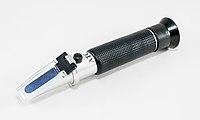
Photo from wikipedia
Abstract Peristalsis is widely seen in nature, as this pumping action is important in digestive systems for conveying sustenance to every corner of the body. In this paper, we propose… Click to show full abstract
Abstract Peristalsis is widely seen in nature, as this pumping action is important in digestive systems for conveying sustenance to every corner of the body. In this paper, we propose a muscle-powered tubular micro pump that provides peristaltic transport. We utilized Drosophila melanogaster larvae that express channelrhodopsin-2 (ChR2) on the cell membrane of skeletal muscles to obtain light-responsive muscle tissues. The larvae were forced to contract with blue light stimulation. While changing the speed of the propagating light stimulation, we observed displacement on the surface of the contractile muscle tissues. We obtained peristaltic pumps from the larvae by dissecting them into tubular structures. The average inner diameter of the tubular structures was about 400 μm and the average outer diameter was about 750 μm. Contractions of this tubular structure could be controlled with the same blue light stimulation. To make the inner flow visible, we placed microbeads into the peristaltic pump, and thus determined that the pump could transport microbeads at a speed of 120 μm·s−1.
Journal Title: Engineering
Year Published: 2019
Link to full text (if available)
Share on Social Media: Sign Up to like & get
recommendations!